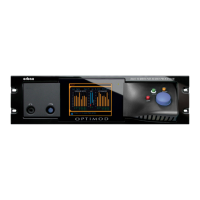OPTIMOD SURROUND PROCESSOR OPERATION
3-59
der gated conditions, because bands 2 and 3 have the same gain.
The gate also independently freezes the gain of the two highest frequency bands
(forcing the gain of the highest frequency band to be identical to its lower
neighbor), and independently sets the gain of the lowest frequency band according
to the setting of the DJ
BASS boost control (in the Equalization screen). Thus, with-
out introducing obvious coloration, the gating smoothly preserves the average
overall frequency response “tilt” of the multiband compressor, broadly maintaining
the “automatic equalization” curve it generates for a given piece of program mate-
rial.
If the
MB GATE control is turned OFF, the DJ BASS control (in the Equaliza-
tion screen) is disabled.
MB Downward Expander
determines the level below which the single-ended
noise reduction system’s downward expander begins to decrease system gain, and
below which the high frequencies begin to become low-pass filtered to reduce per-
ceived noise. Activate the single-ended dynamic noise reduction by setting the MB
DOWNWARD EXPANDER control to a setting other than OFF.
The single-ended noise reduction system combines a broadband downward ex-
pander with a program-dependent low-pass filter. These functions are achieved by
introducing extra gain reduction in the multiband compressor. You can see the ef-
fect of this extra gain reduction on the gain reduction meters.
Ordinarily, the gating on the AGC and multiband limiter will prevent objectionable
build-up of noise, and you will want to use the single-ended noise reduction only on
unusually noisy program material. In sound for picture, it is particularly useful in live
news and sports.
Please note that it is impossible to design such a system to handle all program mate-
rial without audible side effects. You will get best results if you set the MB
DOWNWARD EXPANDER control of the noise reduction system to complement the pro-
gram material you are processing. The MB
DOWNWARD EXPANDER should be set higher
when the input is noisy and lower when the input is relatively quiet. The best way to
adjust the MB
DOWNWARD EXPANDER control is to start with the control set very high.
Reduce the control setting while watching the gain reduction meters. Eventually,
you will see the gain increase in sync with the program. Go further until you begin
to hear noise modulation—a puffing or breathing sound (the input noise) in sync
with the input program material. Set the MB
DOWNWARD EXPANDER control higher
until you can no longer hear the noise modulation. This is the best setting.
Obviously, the correct setting will be different for a sporting event than for classical
music. It may be wise to define several presets with different settings of the MB
DOWNWARD EXPANDER control, and to recall the preset that complements the pro-
gram material of the moment.
Note also that it is virtually impossible to achieve undetectable dynamic noise reduc-
tion of program material that is extremely noisy to begin with, because the program
never masks the noise. It is probably wiser to defeat the dynamic noise reduction

